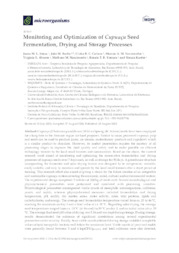Monitoring and optimization of cupuaçu seed fermentation, drying and storage processes.
Monitoring and optimization of cupuaçu seed fermentation, drying and storage processes.
Autoria: SOUZA, J. M. L. de; ROCHA, J. M.; CARTAXO, C. B. da C.; VASCONCELOS, M. A. M. de; ALVARES, V. de S.; NASCIMENTO, M. N.; YOMURA, R. B. T.; KAEFER, S.
Resumo: Cupuaçu [Theobroma grandiflorum (Wild ex Spreng.) K. Schum] seeds have been employed for a long time in the Amazon region for food purposes. Similar to cocoa, processed cupuaçu pulp and seeds can be used to produce juices, ice creams, confectionary products and cupulate®, which is a similar product to chocolate. However, its market penetration requires the mastery of all processing stages to improve the food quality and safety and to make possible an efficient technology transfer to the local small farmers and communities. Based on the above, the current research work aimed at monitoring and optimizing the consecutive fermentation and drying processes of cupuaçu seeds over 7 days each, as well as storage for 90 days. A greenhouse structure incorporating the fermenter and solar drying terrace was designed to be inexpensive, versatile, easily scalable, and easy to maintain and operate by the local small farmers after a short period of training. This research effort also aimed at giving a vision for the future creation of an integrative and sustainable cupuaçu system covering the economic, social, cultural and environmental vectors. The experimental design comprised 5 batches of 100 kg of seeds each. Several microbiological and physicochemical parameters were performed and correlated with processing variables. Microbiological parameters encompassed viable counts of mesophilic microorganisms, coliforms, yeasts, and molds, whereas physicochemical measures included fermentation and drying temperature, pH, acidity, dry matter, ashes, water activity, color, total proteins, lipids and carbohydrates, and energy. The average seed fermentation temperature varied from ca. 28 to 44 °C, reaching the maximum on day 3 and a final value of ca. 31 °C. Regarding solar drying, the average seed temperatures ranged from ca. 24 °C (at the end) to 39 °C on day 3, and an initial value of ca. 29 °C. The average final seed pH value of drying was 5.34 and was kept during storage. During storage, results demonstrated the existence of significant correlations among several experimental parameters under scrutiny. Finally, bean viable counts obtained during storage unfolded acceptable values of total mesophilic bacteria well below the maximum limit. Viable counts of yeast and molds were generally found between 3 and 4 log(CFU/gsample), and total coliforms were also detected, although both were at acceptable levels and well beneath the established maximum limits for food safety.
Ano de publicação: 2020
Tipo de publicação: Artigo de periódico
Unidade: Embrapa Acre
Palavras-chave: Almacenamiento de semillas, Armazenamento, Biotechnology, Biotecnologia, Calidad de las semillas, Cupuaçu, Drying, Fermentación, Fermentation, Fermentação, Processing technology, Qualidade, Secado, Secagem, Seed quality, Seed storage, Tecnología de procesamiento, Theobroma Grandiflorum, Tratamento de Semente
Observações
1 - Por padrão são exibidas publicações dos últimos 20 anos. Para encontrar publicações mais antigas, configure o filtro ano de publicação, colocando o ano a partir do qual você deseja encontrar publicações. O filtro está na coluna da esquerda na busca acima.
2 - Para ler algumas publicações da Embrapa (apenas as que estão em formato ePub), é necessário ter, no celular ou computador, um desses softwares gratuitos. Sistemas Android: Google Play Livros; IOS: iBooks; Windows e Linux: software Calibre.
Acesse outras publicações
Acesse a Base de Dados da Pesquisa Agropecuária (BDPA) para consultar o acervo completo das bibliotecas da Embrapa.

